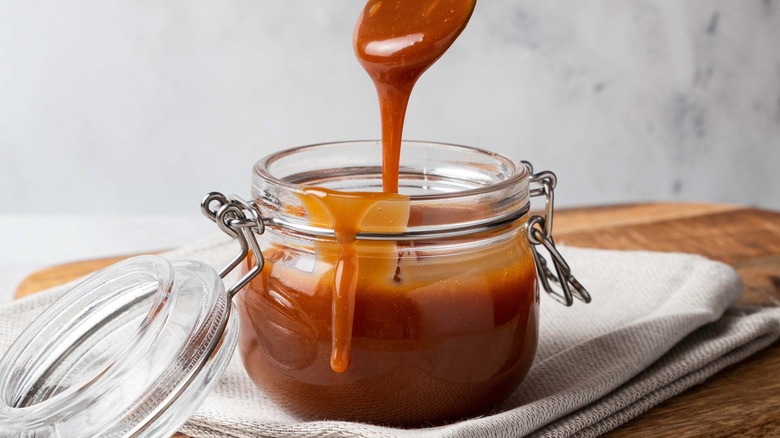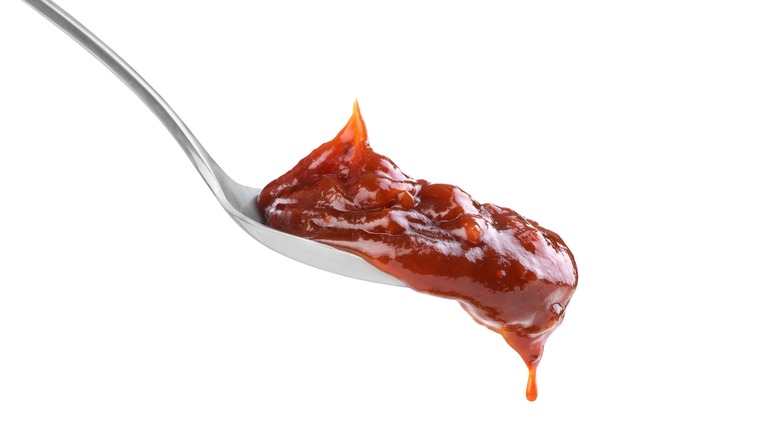Give Caramel A Savory Twist With Fish Sauce
While "sweet tooth" is the flavor-based identity many foodies hew toward, anyone who's ever chowed down on ripe kimchi or ripped a shot of soy sauce just for the thrill of it knows the truth: Umami really is "all that." And fish sauce is the physical embodiment of umami. Equal parts dramatic, funky, and salty, it's made from fermented fish and salt and aged anywhere from a few months to two years or more. The fish is typically anchovies, but it isn't uncommon to see fish sauce made from shrimp, mackerel, or krill. The condiment could be described as a thinner but more potent oyster sauce.
Foodies worldwide stock fish sauce in their home kitchens, but the item appears most commonly in East Asian cooking. In the Philippines, for example, it's called patis and is the key ingredient in pork sinigang stew and lugaw rice porridge. Fish sauce is also one of the main ingredients in Thai cuisine, where it's called nam pla. In fact, fish sauce sits on many Thai restaurant tables like salt and pepper and is considered an essential mealtime fixture. In modern Cambodia, it's known as teuk trei, and to the ancient Romans, it was called garum. As an added bonus, it's also one of those condiments that takes years to go bad, either refrigerated or at room temperature. And, you know what? Your caramel is crying out for it.
Sweet-umami never misses
At first, hitting your gooey caramel with the fragrant, pungent, essentially irreplicable phenom that is fish sauce might seem a little odd. According to a study published in the Journal of Neurophysiology, sweet and umami foods provide "a synergistic (i.e., supra-additive) effect in the subjective experience of taste intensity." In other words, physiologically, your body wants you to combine the sweet-umami flavor by pouring fish sauce into your caramel because they intensify both flavors simultaneously. And fortunately, a trip to Umami Flavor Town is only a matter of adding a few tablespoons of fish sauce in lieu of salt to your favorite homemade caramel recipe.
If you're really feeling like a loose cannon, you could incorporate additional ingredients like honey, lemongrass, red chiles, or brown sugar to make that fish sauce caramel even more complex. Ultimately, its uses are only limited by your imagination, and the savory realm is just the beginning. Here are some ideas to stimulate your salty-sweet tooth and help get an umami brainstorm brewing.
A taste of the sweet (and salty) life
Fish sauce caramel might sound like a modern food trend, like butter boards and zoodles, but it's far from a new idea. In traditional Vietnamese meals, fish sauce caramel is called nuoc mau, and it's a common cooking liquid for chunks of beef and pork belly. It's even a key ingredient in pad Thai. Use it for glazing sticky chicken wings, a rack of ribs, or baked salmon. For plant-based eaters, use caramel fish sauce as a marinade for Brussels sprouts, eggplant, or blow-you-away umami mushrooms. You could even add a tablespoon or two to some coconut milk for a fragrant rice dish.
Are you still feeling a little skeptical about this umami dessert? We invite you to consider it a suitable addition to miso pastries, maple bacon anything, and the entire category of butterscotch. Add a smear of that fish sauce caramel to citrus shortbread cookies or chewy molasses cookies for a knockout treat. Spoon it over vanilla ice cream and load it with toasted nuts for a sweet-savory sundae. If making homemade ice cream is your thing, you could fold that umami caramel directly into your ice cream maker. Adrienne Lo of Chicago restaurant Fat Rice told Taste she uses fish sauce caramel anywhere you might normally use regular salted caramel. And to us, that means using it as a dipping sauce for salted pretzels or green apple slices. You could even whip out your immersion blender and swirl a spoonful into a glass of iced coffee.


